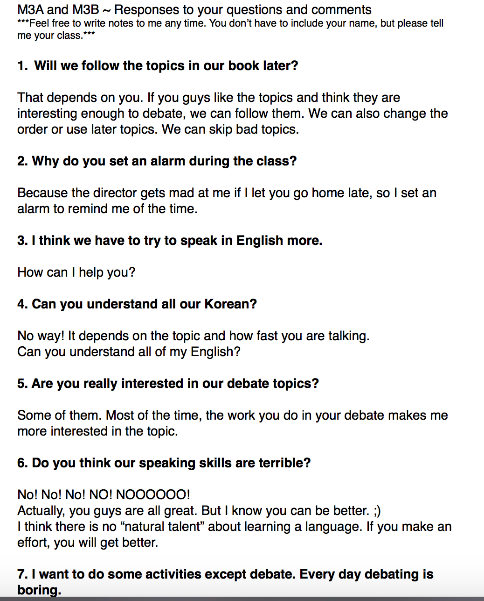 By Anne Hendler
By Anne Hendler
When I started teaching, I had never taken any training. I learned on the job, and it was natural that I learned a lot from my students, even the youngest ones.
I have always valued student feedback. After all, they were really the only ones who saw my classes. Maybe they weren’t experts at teaching or learning, but they were (1) the customers and (2) the benefactors of the experience, and they knew what they liked, what made them feel confident or successful, what was fun, and what was boring. They saw things I didn’t. They saw what happens in the classroom in ways that I didn’t.
Initially I received feedback from students informally – by observing them, or by asking them directly in class or in the hallway, or by listening when they approached me individually or in groups to tell me what they thought.
When I started collecting feedback formally (primarily with teens), I passed out surveys, added a question to the end of their exam, facilitated discussions, and did a variety of activities to get them to express their opinions. It was a process – initially they just wrote vague and positive comments, such as “Everything is great.” “We love you.” It took time to build the trust required for more detailed feedback. After a while, they started giving more specific answers: “I want to do more games.” “I think this project improved my English.”

At that point, I realized that I couldn’t just collect feedback. I had to read it and let the students know I was listening to them. I had to answer their questions and respond to their comments. So whenever I collected feedback, I typed it up into a document or spreadsheet and gave it back to them. We spent some time in class talking about it. Something about writing it all up was really helpful to me as well. Here are some things I learned from this process.
- Strips of colored paper gave students the chance to give feedback about the class in general (blue for things to continue, orange for things to stop, brown for things to change). I found out that I talk too loudly in our small classroom. I was grateful for the response – how else would I have known?
- Likert scales at the end of units to let students respond to class materials, how they are used, and how they could be improved. I learned that my students needed to brush up their summarising skills and that they weren’t doing their homework because it was too difficult, not because they were lazy or busy.
- A round-table discussion in which students responded to my open questionnaire and also asked their own anonymous questions on paper was the best method of all. I dedicated a whole class to it, and I learned that students unanimously wanted more class time to prepare for tasks. It was really helpful feedback because it was a complete mismatch from the impression I had had.

The questions they asked, in their turn, truly revealed the things they cared about. The trust we built through such questions and answers helped to open the door for hallway feedback. I’ll never forget the day a student came to me in the hallway at the end of a long day. Her class had been the last of the day and particularly challenging on that day. She said, “we are tired when we come to your class because of the pressures in our day and our other classes. So maybe we look bored, but really we are doing our best. We just need more time.” Her unsolicited feedback helped me to see the class in a different way and reminded me how valuable it is to build a mutual feedback relationship with students. It developed their reflective skills as well as my own, and gave me another lens through which to observe my classes.

